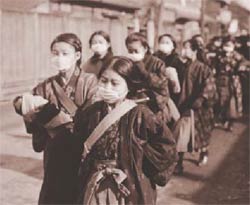
The Magazine of the Pan American Health Organization
Volume 8, Number 3, 2003


Purple Death
The Great Flu of 1918
by Sara Francis Fujimura

Meanwhile back home, schoolgirls jumped rope to a new chant:
I had a little bird
And its name was Enza
I opened the window
And in-flew-Enza
Influenza-more specifically the Spanish flu-left its devastating mark in both world and American history that year. The microscopic killer circled the entire globe in four months, claiming the lives of more than 21 million people. The United States lost 675,000 people to the Spanish flu in 1918-more casualties than World War I, World War II, the Korean War and the Vietnam War combined. Pharmaceutical companies worked around the clock to come up with a vaccine to fight the Spanish flu, but they were too late. The virus disappeared before they could even isolate it.
America's Forgotten Pandemic: The Influenza of 1918, by Alfred Crosby, tells the chilling story of the world's deadliest flu pandemic from a U.S. perspective and also offers many details of the epidemic's international reach. The book was first published in 1990, but following the emergence of severe acute respiratory syndrome (SARS) earlier this year, it was rereleased in paperback in September with a new preface.
Crosby's book and other treatments of the 1918 pandemic (see box at end) make enlightening-if alarming-reading as the Northern Hemisphere's new flu season gets under way.
Despite its name, researchers believe the Spanish flu most likely originated in the United States. One of the first recorded cases was on March 11, 1918, at Fort Riley in Kansas. Overcrowding and unsanitary conditions created a fertile breeding ground for the virus. Within one week, 522 men had been admitted to the camp hospital suffering from the same severe influenza. Soon after, the army reported similar outbreaks in Virginia, South Carolina, Georgia, Florida, Alabama and California. Navy ships docked at East Coast ports also reported outbreaks of severe influenza and pneumonia among their crews. The flu seemed to target military personnel and not civilians, so the virus was largely overshadowed by hotter current affairs such as Prohibition, the suffragette movement and the bloody battles in Europe.
By May 1918, influenza began to subside in the United States. But the ordeal was by no means over. Soldiers at Fort Riley, now ready for battle, incubated the virus during their long, cramped voyage to France. Once they hit French shores, the virus exploded, striking the Allied forces and Central Powers with equal force. The Americans fell ill with "three-day fever" or "purple death." The French caught "purulent bronchitis." The Italians suffered "sand fly fever." German hospitals filled with victims of Blitzkatarrh or "Flanders fever."
No matter what they called it, the virus attacked everyone similarly. It started like any other influenza case, with a sore throat, chills and fever. Then came the deadly twist: the virus ravaged its victim's lungs. Sometimes within hours, patients succumbed to complete respiratory failure. Autopsies showed hard, red lungs drenched in fluid. A microscopic look at diseased lung tissue revealed that the alveoli, the lungs' normally air-filled cells, were so full of fluid that victims literally drowned. The slow suffocation began when patients presented with a unique symptom: mahogany spots over their cheekbones. Within hours these patients turned a bluish-black hue indicative of cyanosis, or lack of oxygen. When triaging scores of new patients, nurses often looked at the patients' feet first. Those with black feet were considered beyond help and were carted off to die.
What made this influenza especially baffling to health care workers was that it attacked healthy, strong adults most often. Normally, flu is only life-threatening to the elderly, young children and people with compromised immune systems. Many adults become sick, but very few die. Spanish flu turned the tables on this pattern. Disproportionate numbers of men and women-especially pregnant women-died, leaving their orphaned children behind.
The Spanish lady
Spanish flu, sometimes called the "Spanish Lady," received its misnomer thanks largely to wartime censorship. Both the Allied forces and Central Powers had amassed huge losses due to Spanish flu, but the warring parties stifled reports to hide information that could be valuable to the enemy. However, uncensored newspapers in Spain openly reported the deaths from flu of millions of Spaniards in May and June of 1918-reports that were picked up by media around the world. Spain, outraged at the unflattering epithet, pointed its finger at France, saying the disease had come from its battlefields and had flown over the Pyrenees mountains carried by the wind. The misnomer, however, endured.
From the battlefields of Europe, the epidemic quickly evolved into a pandemic, as the disease spread north to Norway, east to China, southeast to India and as far south as New Zealand. Even islands weren't safe. Hitching rides on naval ships and carriers, merchant vessels and trains, the virus traveled to the four corners of the earth. By the summer of 1918, it had hit Puerto Rico, the Caribbean, the Philippines and Hawaii. The epidemic wreaked havoc on Puerto Rico but surprisingly barely touched the Panama Canal Zone, the crossroads of the world at the time. The steamship Harold Walker is blamed for bringing Spanish flu to Tampico, Mexico. Within four short months, the virus had rounded the globe and returned once more to U.S. shores.
The second and third waves of Spanish flu slammed the United States in the cold-weather months of 1918. This time civilians were not immune. The country's indigenous people, particularly Native Alaskans, suffered disproportionately. The flu completely wiped out some villages in Alaska, and others lost most of their adult population. Big-city dwellers faired poorly too. New York City buried 33,000 victims. Philadelphia lost nearly 13,000 people in a matter of weeks. Overwhelmed with bodies, many cities soon ran out of coffins and some had to convert streetcars into hearses to keep up with demand.
Crosby described how overburdened undertakers were:
In some cases the dead were left in their homes for days. Private undertaking houses were overwhelmed, and some were taking advantage of the situation by hiking prices as much as 600 percent. Complaints were made that cemetery officials were charging fifteendollar burial fees and then making the bereaved dig the graves for their dead themselves.
Life came to a standstill in some parts of the United States. Boston officials closed public schools, saloons and soda shops. Chicago police officers were ordered to arrest anyone sneezing or coughing in public. In Nashville, all public gatherings-including in movie houses, dance halls and pool parlors- were prohibited. Even ministers were ordered not to hold church services.

Crosby details the desperation: "Many families, especially in the slums, had no adult well enough to prepare food and in some cases had no food at all because the breadwinner was sick or dead."
Jeffery Taubenberger, chief of cellular pathology and genetics at the U.S. Armed Forces Institute of Pathology and a world-renowned leader in Spanish flu research, estimates that about a third of the U.S. population was infected with Spanish flu. "There was a massive shortage of medical care of all kinds," he says. Many cities' health care services were already overtaxed by the war. For example, one-third of Nashville's doctors were treating service people overseas when Spanish flu hit. Nurses became an invaluable asset to communities as the remaining doctors quickly became overwhelmed and in many cases sick themselves with the Spanish flu.
Crosby describes the horrors facing nurses, some fresh out of school and with little practical experience:
Visiting nurses often walked into scenes resembling those of the plague years of the fourteenth century….One nurse found a husband dead in the same room where his wife lay with newly born twins. It had been twenty-four hours since the death and the births, and the wife had had no food but an apple which happened to lie within reach.
Every year, the world catches a new influenza virus. Many people become infected, and many die. But what made the 1918 pandemic so particularly deadly? Like other viruses, the influenza virus changes constantly. This mutation, or antigenic drift, normally causes only minor changes, so pharmaceutical companies are able to counteract each year's strain with the proper flu vaccine. However, as historical records dating from the 1700s show, every 10 to 40 years the world suffers a global flu pandemic, the result of a major antigenic drift. The virus mutates so much that the human body no longer recognizes it and is left defenseless. The resulting epidemic spreads faster than scientists can isolate, produce and distribute a vaccine. This is what happened in 1918.
"History tells us we are ready for another pandemic," says Kirsty Duncan, Spanish flu researcher and author of Hunting the 1918 Flu: One Scientist's Search for a Killer Virus. "In many ways we are even more vulnerable now than in 1918. We travel and tour the world more. You can travel from one continent to another in a matter of hours now. Someone unknowingly harboring a disease can bring it from one country to another, passing the disease along to other travelers before they ever show signs of the disease."
Would the world be able to cope with another flu pandemic? Yes, says Robert Webster, chief virologist at St. Jude Children's Research Hospital and an expert on influenza. He cites Taubenberger's pioneering work in developing new techniques for analyzing genetic changes in influenza viruses. His findings suggest that "should something like the Spanish flu return, today's flu drugs-Tamiflu, Flumadine, Symmetrel, and Relenza-would all be effective," Webster says, adding: "With today's technology to add to Taubenberger's results, drug companies could get a vaccine ready very quickly."
What about a new, non-influenza virus, like the one that causes SARS? "Quarantine and hygiene put the SARS virus back in the bottle," says Webster. "It would not have been possible to do so with an influenza. It would travel too fast to be contained by quarantine and hygiene alone."
Sara Francis Fujimura is a freelance writer based in Arizona, USA. She is currently at work on a young adult novel set during the 1918 flu outbreak in Nashville, Tennessee.